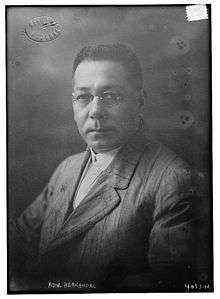Adriano Hernández
Adriano Hernández y Dayot (September 8, 1870 – February 16, 1925), was a Filipino revolutionary, patriot and military strategist during the Philippine Revolution and the Philippine-American War.
Adriano Hernández y Dayot | |
|---|---|
 Hernandez in 1916 | |
| Born | September 8, 1870 |
| Died | February 16, 1925 (aged 54) |
| Nationality | Filipino |
| Occupation | revolutionary, patriot, military strategist, farmer |
Early life
Hernández was born on September 8, 1870 to Fernando Hernández and Lucía Dayot, a member of a prominent family in Dingle, Iloilo. He was a Spanish mestizo who studied at the Escuela Católica de Dingle (Dingle Catholic School) in Dingle, Iloilo and later at the Ateneo Municipal in Manila.[1]
Military career
During the Philippine Revolution, Hernández organized a revolutionary movement in Iloilo against the Spanish colonial authorities and then from 1898, against the United States. He was a leader, along with Julio Hernández and Nicolas Roces, of the Cry of Lincud which occurred on October 28, 1898, at Barrio Lincud in Dingle. This event is known today as the first armed uprising for independence in the province of Iloilo. He then became an aide to General Martín Delgado because of his knowledge in military strategy.[2] He was designated Chief of Staff of the revolutionary government in the Visayas in November 1898 and represented the province of Iloilo at the Malolos Congress. During the Philippine-American War, Hernández led the guerrilla movement in the province until he surrendered.
Post-war life
Hernández became a member of the first Philippine Assembly in 1907, the first nationally elected legislative body in the Philippines, the lower house of the Philippine Legislature of the American colonial Insular Government. In 1912, he was elected Governor of Iloilo, as a member of the Nacionalista Party. A practicing farmer, Hernández became the first Filipino director of the Bureau of Agriculture in 1916, which had been headed by Americans colonial officials before his tenure.[3] This was part of the Filipinization policy of the American colonial government, following the Jones Act of 1916.
Hernández died on February 16, 1925.
Commemoration
- Camp General Adriano D. Hernandez in Dingle, Iloilo is named in his honor.[4] It serves as headquarters of the 301st Infantry Brigade of the 3rd Infantry Division of the Philippine Army.
- The Cry of Lincud Heroes memorial in Dingle, Iloilo was erected in his honor on the site of the initial uprising.
- The Gen. Adriano D. Hernandez monument is a bronze monument located in the Dingle town plaza erected in his honor.
References
- Quirino, Carlos (1995). Who's who in Philippine History. Tahanan Books.
- Marin, Bombette G. (October 19, 2011). "Pagdihon Festival in Dingle". Iloilo News Today. Archived from the original on July 30, 2013. Retrieved November 21, 2012.
- "History, Department of Agriculture". Archived from the original on December 28, 2012. Retrieved November 21, 2012.
- "47th Infantry Battalion prepares for redeployment to Southern Negros". Balita.ph. November 8, 2010. Retrieved November 21, 2012.